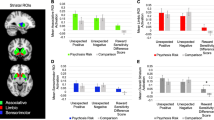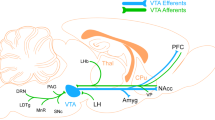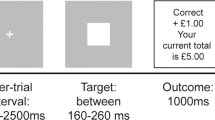Abstract
While dopamine systems have been implicated in the pathophysiology of schizophrenia and psychosis for many years, how dopamine dysfunction generates psychotic symptoms remains unknown. Recent theoretical interest has been directed at relating the known role of midbrain dopamine neurons in reinforcement learning, motivational salience and prediction error to explain the abnormal mental experience of psychosis. However, this theoretical model has yet to be explored empirically. To examine a link between psychotic experience, reward learning and dysfunction of the dopaminergic midbrain and associated target regions, we asked a group of first episode psychosis patients suffering from active positive symptoms and a group of healthy control participants to perform an instrumental reward conditioning experiment. We characterized neural responses using functional magnetic resonance imaging. We observed that patients with psychosis exhibit abnormal physiological responses associated with reward prediction error in the dopaminergic midbrain, striatum and limbic system, and we demonstrated subtle abnormalities in the ability of psychosis patients to discriminate between motivationally salient and neutral stimuli. This study provides the first evidence linking abnormal mesolimbic activity, reward learning and psychosis.
This is a preview of subscription content, access via your institution
Access options
Subscribe to this journal
Receive 12 print issues and online access
$259.00 per year
only $21.58 per issue
Buy this article
- Purchase on Springer Link
- Instant access to full article PDF
Prices may be subject to local taxes which are calculated during checkout




Similar content being viewed by others
References
Crow TJ . Positive and negative schizophrenia symptoms and the role of dopamine. Br J Psychiatry 1981; 139: 251–254.
Laruelle M, Kegeles LS, Abi-Dargham A . Glutamate, dopamine, and schizophrenia: from pathophysiology to treatment. Ann N Y Acad Sci 2003; 1003: 138–158.
Angrist B, Sathananthan G, Wilk S, Gershon S . Amphetamine psychosis: behavioral and biochemical aspects. J Psychiatr Res 1974; 11: 13–23.
Krystal JH, Perry Jr EB, Gueorguieva R, Belger A, Madonick SH, Abi-Dargham A et al. Comparative and interactive human psychopharmacologic effects of ketamine and amphetamine: implications for glutamatergic and dopaminergic model psychoses and cognitive function. Arch Gen Psychiatry 2005; 62: 985–994.
Laruelle M, Abi-Dargham A, van Dyck CH, Gil R, D’Souza CD, Erdos J et al. Single photon emission computerized tomography imaging of amphetamine-induced dopamine release in drug-free schizophrenic subjects. Proc Natl Acad Sci USA 1996; 93: 9235–9240.
Breier A, Su TP, Saunders R, Carson RE, Kolachana BS, de Bartolomeis A et al. Schizophrenia is associated with elevated amphetamine-induced synaptic dopamine concentrations: evidence from a novel positron emission tomography method. Proc Natl Acad Sci USA 1997; 94: 2569–2574.
Kapur S, Remington G . Dopamine D(2) receptors and their role in atypical antipsychotic action: still necessary and may even be sufficient. Biol Psychiatry 2001; 50: 873–883.
Gray JA . Integrating schizophrenia. Schizophr Bull 1998; 24: 249–266.
Crow TJ . Catecholamine reward pathways and schizophrenia: the mechanism of the antipsychotic effect and the site of the primary disturbance. Fed Proc 1979; 38: 2462–2467.
Miller R . Schizophrenic psychology, associative learning and the role of forebrain dopamine. Med Hypotheses 1976; 2: 203–211.
Gray JA, Feldon J, Rawlins JNP, Smith AD . The neuropsychology of schizophrenia. Behav Brain Sci 1991; 14: 1–19.
Schultz W, Dayan P, Montague PR . A neural substrate of prediction and reward. Science 1997; 275: 1593–1599.
Schultz W, Dickinson A . Neuronal coding of prediction errors. Annu Rev Neurosci 2000; 23: 473–500.
Crow TJ . Catecholamine-containing neurones and electrical self-stimulation. 2. A theoretical interpretation and some psychiatric implications. Psychol Med 1973; 3: 66–73.
Berridge KC . The debate over dopamine's role in reward: the case for incentive salience. Psychopharmacology (Berl) 2007; 191: 391–431.
Berridge KC, Robinson TE . What is the role of dopamine in reward: hedonic impact, reward learning, or incentive salience? Brain Res Brain Res Rev 1998; 28: 309–369.
Robbins TW, Everitt BJ . A role for mesencephalic dopamine in activation: commentary on Berridge (2006). Psychopharmacology (Berl) 2006.
Bleuler E . Dementia Praecox or the Group of Schizophrenias. International University Press: New York, 1911/1950.
Kapur S . Psychosis as a state of aberrant salience: a framework linking biology, phenomenology, and pharmacology in schizophrenia. Am J Psychiatry 2003; 160: 13–23.
Beninger RJ . The slow therapeutic action of antipsychotic drugs. A possible mechanism involving the role of dopamine in incentive learning. In: Simon P, Soubrie P, Widlocher D (eds). Selected Models of Anxiety, Depression and Psychosis. Basel: Karger, 1988, pp 36–51.
O’Doherty J, Dayan P, Schultz J, Deichmann R, Friston K, Dolan RJ . Dissociable roles of ventral and dorsal striatum in instrumental conditioning. Science 2004; 304: 452–454.
Sutton RS, Barto AG . Reinforcement Learning. MIT Press: Cambridge, MA, 1998.
Pessiglione M, Seymour B, Flandin G, Dolan RJ, Frith CD . Dopamine-dependent prediction errors underpin reward-seeking behaviour in humans. Nature 2006; 442: 1042–1045.
Nelson HE . The National Adult Reading Test (NART). NFER-Nelson: Windsor, 1982.
Woods SW . Chlorpromazine equivalent doses for the newer atypical antipsychotics. J Clin Psychiatry 2003; 64: 663–667.
Ventura J, Green MF, Shaner A, Lieberman RP . Training and quality assurance with the Brief Psychiatric Rating Scale: ‘The Drift Buster’. Int J Methods Psychiatric Res 1993; 3: 221–224.
Cools R, Blackwell A, Clark L, Menzies L, Cox S, Robbins TW . Tryptophan depletion disrupts the motivational guidance of goal-directed behavior as a function of trait impulsivity. Neuropsychopharmacology 2005; 30: 1362–1373.
Henson R . Analysis of fMRI timeseries: Linear Time-Invariant models, event-related fMRI and optimal experimental design. In: Frackowiak R, Friston K, Frith C, Dolan R, Price C (eds). Human Brain Function. Elsevier: London, 2004, pp 793–822.
Genovese CR, Lazar NA, Nichols T . Thresholding of statistical maps in functional neuroimaging using the false discovery rate. Neuroimage 2002; 15: 870–878.
Aron AR, Shohamy D, Clark J, Myers C, Gluck MA, Poldrack RA . Human midbrain sensitivity to cognitive feedback and uncertainty during classification learning. J Neurophysiol 2004; 92: 1144–1152.
Rorden C, Brett M . Stereotaxic display of brain lesions. Behav Neurol 2000; 12: 191–200.
Martinez D, Slifstein M, Broft A, Mawlawi O, Hwang DR, Huang Y et al. Imaging human mesolimbic dopamine transmission with positron emission tomography. Part II: amphetamine-induced dopamine release in the functional subdivisions of the striatum. J Cereb Blood Flow Metab 2003; 23: 285–300.
Fine C, Gardner M, Craigie J, Gold I . Hopping, skipping or jumping to conclusions? Clarifying the role of the JTC bias in delusions. Cogn Neuropsychiatry 2007; 12: 46–77.
Breiter HC, Aharon I, Kahneman D, Dale A, Shizgal P . Functional imaging of neural responses to expectancy and experience of monetary gains and losses. Neuron 2001; 30: 619–639.
O’Doherty JP, Deichmann R, Critchley HD, Dolan RJ . Neural responses during anticipation of a primary taste reward. Neuron 2002; 33: 815–826.
Knutson B, Bjork JM, Fong GW, Hommer D, Mattay VS, Weinberger DR . Amphetamine modulates human incentive processing. Neuron 2004; 43: 261–269.
Breiter HC, Gollub RL, Weisskoff RM, Kennedy DN, Makris N, Berke JD et al. Acute effects of cocaine on human brain activity and emotion. Neuron 1997; 19: 591–611.
Robbins TW, Everitt BJ . Neurobehavioural mechanisms of reward and motivation. Curr Opin Neurobiol 1996; 6: 228–236.
Juckel G, Schlagenhauf F, Koslowski M, Filonov D, Wustenberg T, Villringer A et al. Dysfunction of ventral striatal reward prediction in schizophrenic patients treated with typical, not atypical, neuroleptics. Psychopharmacology (Berl) 2006; 187: 222–228.
McKenna PJ . Pathology, phenomenology and the dopamine hypothesis of schizophrenia. Br J Psychiatry 1987; 151: 288–301.
Beninger RJ . The role of dopamine in locomotor activity and learning. Brain Res 1983; 287: 173–196.
Robbins TW . Relationship between reward-enhancing and stereotypical effects of psychomotor stimulant drugs. Nature 1976; 264: 57–59.
Robbins TW . Cognitive deficits in schizophrenia and parkinson's disease: neural basis and the role of dopamine. In: Willner P, Scheel-Kruger J (eds). The Mesolimbic Dopamine System: From Motivation to Action. Wiley: Chichester, UK, 1991, pp 497–528.
Juckel G, Schlagenhauf F, Koslowski M, Wustenberg T, Villringer A, Knutson B et al. Dysfunction of ventral striatal reward prediction in schizophrenia. Neuroimage 2006; 29: 409–416.
Jones SH, Gray JA, Hemsley DR . Loss of the Kamin blocking effect in acute but not chronic schizophrenics. Biol Psychiatry 1992; 32: 739–755.
Corlett PR, Honey GD, Aitken MR, Dickinson A, Shanks DR, Absalom AR et al. Frontal responses during learning predict vulnerability to the psychotogenic effects of ketamine: linking cognition, brain activity, and psychosis. Arch Gen Psychiatry 2006; 63: 611–621.
Acknowledgements
Graham Murray was supported by a Department of Health Research Capacity Development Award. Paul Fletcher is supported by the Wellcome Trust. The work was completed within the University of Cambridge Behavioural and Clinical Neuroscience Institute, supported by a joint award from the Wellcome Trust and Medical Research Council. CAMEO received pump priming funding from the Stanley Medical Research Institute and GlaxoSmithKline, and now receives support from the UK National Health Service. We are grateful to staff from CAMEO and the Wolfson Brain Imaging Centre for their help with recruitment and data collection, and to the participants.
Author information
Authors and Affiliations
Corresponding author
Additional information
Supplementary Information accompanies the paper on the Molecular Psychiatry website (http://www.nature.com/mp)
Supplementary information
Rights and permissions
About this article
Cite this article
Murray, G., Corlett, P., Clark, L. et al. Substantia nigra/ventral tegmental reward prediction error disruption in psychosis. Mol Psychiatry 13, 267–276 (2008). https://doi.org/10.1038/sj.mp.4002058
Received:
Revised:
Accepted:
Published:
Issue Date:
DOI: https://doi.org/10.1038/sj.mp.4002058
Keywords
This article is cited by
-
Schizophrenia: from neurochemistry to circuits, symptoms and treatments
Nature Reviews Neurology (2024)
-
Reduced learning bias towards the reward context in medication-naive first-episode schizophrenia patients
BMC Psychiatry (2022)
-
Aberrant salience relationship with first rank symptoms
Annals of General Psychiatry (2022)
-
Neural substrates of reward anticipation and outcome in schizophrenia: a meta-analysis of fMRI findings in the monetary incentive delay task
Translational Psychiatry (2022)
-
The prediction-error hypothesis of schizophrenia: new data point to circuit-specific changes in dopamine activity
Neuropsychopharmacology (2022)



